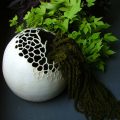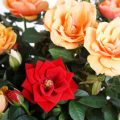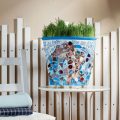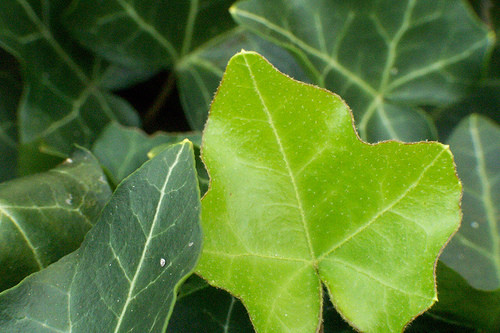 Ivy plantIvy is an evergreen liana made offamily Araliaceae. In nature, it is widespread in dry and humid subtropics of Europe, America, North Africa and Asia. There are 15 species in the genus. The most famous is common ivy (Hedera helix). There are countless varieties and cultivars of this ivy for growing indoors, differing in the size, shape and color of the leaves. The most original form is the cristate (Hedera cristata) with large, rounded, corrugated leaves, variegated or even completely white in color. Common ivy grows quickly. Its stems have aerial suckers, with the help of which the plant easily climbs up. Less common is Canary ivy (Hedera canariensis). It has larger leaves, but it grows slowly, and its shoots do not have aerial roots, so it needs supports. Ivy - the plant is hardy, withstanding both heat and drafts, although windows facing north and cool rooms are most favorable for it, especially for pure green varieties. Variegated plants require more light, but do not tolerate bright sun. In dark places and in the sun, their variegation may disappear. Ivy is undemanding to the soil. It can be planted in any soil mixture: both rich in humus and poor. Most often, the substrate is made up of equal parts of washed sand, turf soil and humus. But you can plant it in any other mixture, in the one that you have at hand, the ivy will not die and will even grow well. Ivy does not bloom indoors, in natural conditions it blooms if the plants, having climbed to the top of the tree, come from the shade into the light. Flowers, collected in hemispherical umbrellas, appear in September – October, and in winter you can see blue-black poisonous berries on the shoots. They ripen the following spring. In summer, the plant is watered abundantly, but too much watering can lead to yellowing of the leaves. In winter, less water is required for watering, but you should not let the earth lump dry out. From time to time, the ends of the ivy stems are pinched so that lateral shoots grow. The cut off tops are used as cuttings. Be sure to remove green shoots that sometimes appear on plants with variegated leaves.
Ivy plantIvy is an evergreen liana made offamily Araliaceae. In nature, it is widespread in dry and humid subtropics of Europe, America, North Africa and Asia. There are 15 species in the genus. The most famous is common ivy (Hedera helix). There are countless varieties and cultivars of this ivy for growing indoors, differing in the size, shape and color of the leaves. The most original form is the cristate (Hedera cristata) with large, rounded, corrugated leaves, variegated or even completely white in color. Common ivy grows quickly. Its stems have aerial suckers, with the help of which the plant easily climbs up. Less common is Canary ivy (Hedera canariensis). It has larger leaves, but it grows slowly, and its shoots do not have aerial roots, so it needs supports. Ivy - the plant is hardy, withstanding both heat and drafts, although windows facing north and cool rooms are most favorable for it, especially for pure green varieties. Variegated plants require more light, but do not tolerate bright sun. In dark places and in the sun, their variegation may disappear. Ivy is undemanding to the soil. It can be planted in any soil mixture: both rich in humus and poor. Most often, the substrate is made up of equal parts of washed sand, turf soil and humus. But you can plant it in any other mixture, in the one that you have at hand, the ivy will not die and will even grow well. Ivy does not bloom indoors, in natural conditions it blooms if the plants, having climbed to the top of the tree, come from the shade into the light. Flowers, collected in hemispherical umbrellas, appear in September – October, and in winter you can see blue-black poisonous berries on the shoots. They ripen the following spring. In summer, the plant is watered abundantly, but too much watering can lead to yellowing of the leaves. In winter, less water is required for watering, but you should not let the earth lump dry out. From time to time, the ends of the ivy stems are pinched so that lateral shoots grow. The cut off tops are used as cuttings. Be sure to remove green shoots that sometimes appear on plants with variegated leaves.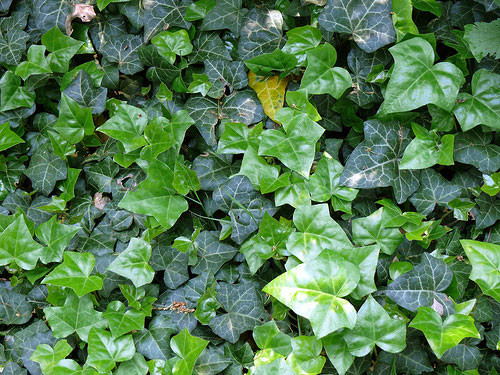 Ivy is replanted in spring:young plants - annually, adults - every other year in larger diameter pots. Of the disadvantages of ivy, only possible drying of leaves is noted. This happens in winter due to low air humidity, when the central heating batteries are on. But regular spraying of leaves allows you to avoid such trouble. The leaves on the ivy usually last a long time, but if the old stems suddenly begin to bare, no problem. It is worth pressing them to the ground with wire and sprinkling with earth or pressing down with moss, and they will take root without much difficulty. It is better to cut off too overgrown bare stems and divide them into cuttings; the "stump" left in the pot will give new shoots in a month or two. Cuttings placed in water give roots at any time of the year. In greenhouses, where the air is more humid, they can be planted directly in pots with loose soil. They take root quickly. For a greater decorative effect, 3-5 cuttings 8-20 centimeters long are placed in each pot. The most common pests on ivy are spider mites and scale insects. To prevent plants from getting sick, they are regularly washed in the shower and periodically, at least once every two to three months, treated with phytoverm (see "Science and Life" 7, 1998) or karate for red spider mites. It is much more difficult to fight the scale insect, systemic insecticides are required, such as actellic. Therefore, when buying, it is necessary to carefully examine all the leaves on the plants so as not to miss the pest. Ivy tree
Ivy is replanted in spring:young plants - annually, adults - every other year in larger diameter pots. Of the disadvantages of ivy, only possible drying of leaves is noted. This happens in winter due to low air humidity, when the central heating batteries are on. But regular spraying of leaves allows you to avoid such trouble. The leaves on the ivy usually last a long time, but if the old stems suddenly begin to bare, no problem. It is worth pressing them to the ground with wire and sprinkling with earth or pressing down with moss, and they will take root without much difficulty. It is better to cut off too overgrown bare stems and divide them into cuttings; the "stump" left in the pot will give new shoots in a month or two. Cuttings placed in water give roots at any time of the year. In greenhouses, where the air is more humid, they can be planted directly in pots with loose soil. They take root quickly. For a greater decorative effect, 3-5 cuttings 8-20 centimeters long are placed in each pot. The most common pests on ivy are spider mites and scale insects. To prevent plants from getting sick, they are regularly washed in the shower and periodically, at least once every two to three months, treated with phytoverm (see "Science and Life" 7, 1998) or karate for red spider mites. It is much more difficult to fight the scale insect, systemic insecticides are required, such as actellic. Therefore, when buying, it is necessary to carefully examine all the leaves on the plants so as not to miss the pest. Ivy tree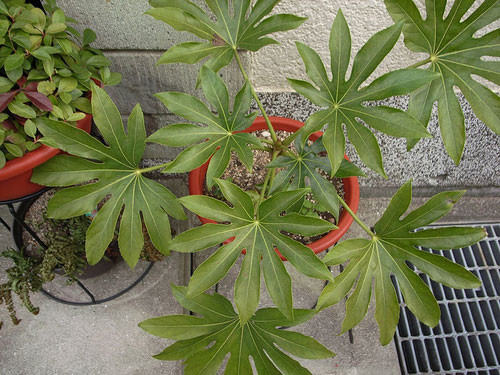 Fatsia japonicaTo get such a tree,Two or three shoots of any ivy are grafted onto Japanese fatsia (indoor aralia) or fatshedera. Japanese fatsia (Fatsia gapenica) is an indoor plant with bright green shiny leaves for cool (6-16°C) and bright rooms. Fatshedera is an unpretentious, fast-growing hybrid of fatsia and ivy with shiny green or variegated-whitish leaves, smaller than those of fatsia. It grows well even in a place that is not very bright. As the young rootstock (fatsia or fatshedera) grows, all lateral shoots are removed, leaving the leaves. When the main shoot (the trunk of the future tree) reaches the desired height (from 0.5 to 1 m), its top is cut off, and the trunk itself is tied to a support. On the cut top, 2.5 cm deep cuts are made and four ivy cuttings are inserted into them. The junction is tied with natural fiber twine. The grafted plant is kept at a temperature of 16°C and high air humidity, which promotes better fusion of the graft.
Fatsia japonicaTo get such a tree,Two or three shoots of any ivy are grafted onto Japanese fatsia (indoor aralia) or fatshedera. Japanese fatsia (Fatsia gapenica) is an indoor plant with bright green shiny leaves for cool (6-16°C) and bright rooms. Fatshedera is an unpretentious, fast-growing hybrid of fatsia and ivy with shiny green or variegated-whitish leaves, smaller than those of fatsia. It grows well even in a place that is not very bright. As the young rootstock (fatsia or fatshedera) grows, all lateral shoots are removed, leaving the leaves. When the main shoot (the trunk of the future tree) reaches the desired height (from 0.5 to 1 m), its top is cut off, and the trunk itself is tied to a support. On the cut top, 2.5 cm deep cuts are made and four ivy cuttings are inserted into them. The junction is tied with natural fiber twine. The grafted plant is kept at a temperature of 16°C and high air humidity, which promotes better fusion of the graft.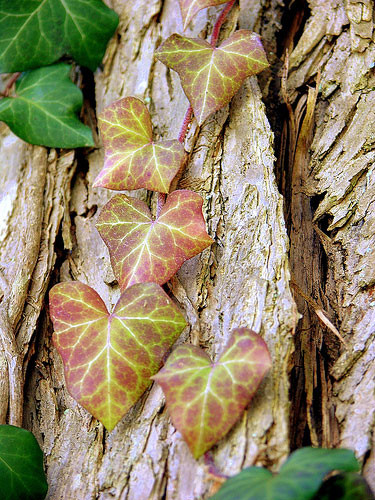 In the style of bonsai For an elegant, tinya narrow-leaved ivy shape is suitable. The plant is planted in small dishes of small volume, better neutral tone and rectangular shape. Soil is picked up stony: in equal parts turf soil, humus, sand and brick crumb. As a rock, a stone is used with comfortable grooves capable of holding the roots of ivy and soil sufficient for its nutrition. One of the main shoots of ivy, as they grow, tilt over the rock, and it soon acquires a naturally drooping appearance. To ivy bush, other shoots often pinch. The composition is held on a sunny window, under the scorching rays. In such extreme conditions, ivy slows down its growth.
In the style of bonsai For an elegant, tinya narrow-leaved ivy shape is suitable. The plant is planted in small dishes of small volume, better neutral tone and rectangular shape. Soil is picked up stony: in equal parts turf soil, humus, sand and brick crumb. As a rock, a stone is used with comfortable grooves capable of holding the roots of ivy and soil sufficient for its nutrition. One of the main shoots of ivy, as they grow, tilt over the rock, and it soon acquires a naturally drooping appearance. To ivy bush, other shoots often pinch. The composition is held on a sunny window, under the scorching rays. In such extreme conditions, ivy slows down its growth.

Making Money with Desserts: Success Stories
Evgeniya Polischuk (Fedutinova) instagram:@evgeniyafedutinovavk.com/janeshomebaking– It all started with baking for family and friends. Gradually, I started posting photos of my baked goods on Instagram – and orders started coming in. I made my first custom-made cake on October 13, 2014, and a little earlier I started making macaroons and cupcakes. You could say that the business “found me”, I am very […]

Soups are cold recipes with photos
Cold cucumber soup with yogurt and lemonsorbet from the chef of the restaurant La Taverna Alexander Zhurkin Photo: Getty Images Ingredients: Plain yoghurt – 125 g Cucumber – 150 g Lemon/lime sorbet – 50 g Cocktail shrimp – 24 g Fresh ginger juice – 1 g Lime juice – 5 g Fresh orange juice – 5 g Parsley – 1 g Pink pepper – 1 g Watercress – […]

barbeque kebab
Pork tenderloin in glaze Photo:Dmitry Bayrak/dbstudioPreparation time: 20 minutes + marinating time.Calories: 454 kcal per serving.For 4 servings: 4 pork tenderloins (approximately 300 g each), 1 onion, 2 cloves of garlic, 1 tsp. lemon zest, 1 tsp. lemon juice, a pinch of ground cumin, coriander and turmeric, 1 tbsp. vegetable […]

Pierre Duacan: dietary recipes: Ducane diet
Beetroot soup Photo:Season’S, Luxury Hotels RepresentationYou will need:· Boiled beetroot – 60 g· Fresh cucumbers – 20 g· Red radish – 20 g· Green onions – 10 g· Egg – 1 pc.· Drinking mineral water – 200 g· Salt – 1 gPreparation:· Boil the egg and beetroot.· Grate the cucumbers, radish and part of the beetroot. Put everything […]
